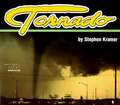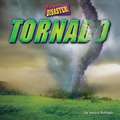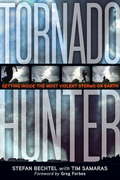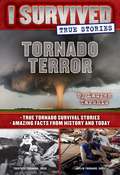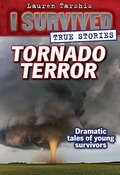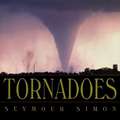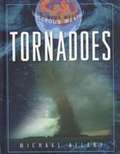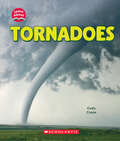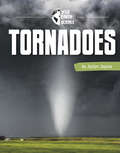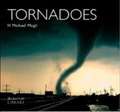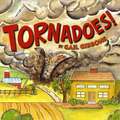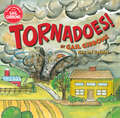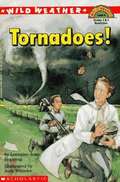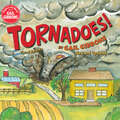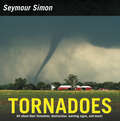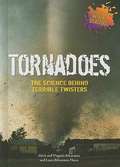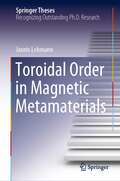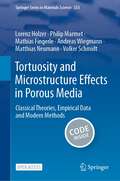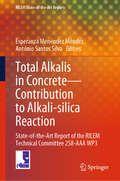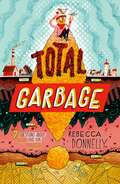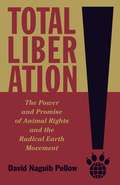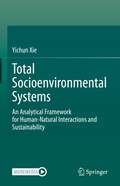- Table View
- List View
Tornado
by National Geographic SocietyPete's dog, Tornado, was no ordinary dog. He came in a Tornado, but when his real owners see him, will Pete lose Tornado?
Tornado (It's a Disaster!)
by Jessica RudolphMany of the facts presented here will astound readers; for instance, a tsunami can travel up to 600 miles per hour, and tornado winds are faster than those of any other storm. Images complement the subjects being described, and each book includes useful back matter.
Tornado Hunter: Getting Inside the Most Violent Storms on Earth
by Stefan Bechtel Tim SamarasOf nature's weapons, tornadoes are among the most unforgiving. Here is an unforgettable portrait of these storms and one extraordinary man who challenged them.
Tornado Terror: True Tornado Survival Stories And Amazing Facts From History And Today (I Survived True Stories Series #3)
by Lauren TarshisThe Tri-State Tornado of 1925 was the deadliest tornado strike in American history, tearing through three states and killing 700 people. Almost a century later, the Joplin Tornado was a mile-wide monster that nearly destroyed the heart of a vibrant city. <P><P>The author of the New York Times best-selling I Survived series now brings you the vivid and true stories of two young people who survived these terrifying twisters, along with fascinating facts about tornadoes and profiles of the well-respected scientists and storm chasers who study them.
Tornado Terror: True Tornado Survival Stories and Amazing Facts from History and Today (I Survived True Stories #3)
by Lauren TarshisFrom the author of the New York Times bestselling I Survived series, comes two gripping accounts of two young people who survived two terrifying twisters.The Tri-State Tornado of 1925 was the deadliest tornado strike in American history, tearing through three states and killing 700 people. Almost a century later, the Joplin Tornado was a mile-wide monster that nearly destroyed theheart of a vibrant city. The author of the New York Times best-selling I Survived series now brings you the vivid and true stories of two young people who survived these terrifying twisters, along with fascinating facts abouttornadoes and profiles of the well-respected scientists and storm chasers who study them.
Tornadoes
by Seymour SimonDescribes the location, nature, development, measurement, and destructive effects of tornadoes, as well as how to stay out of danger from them.
Tornadoes (Dangerous Weather)
by Michael AllabyIn the city of Zenia, Ohio, a tornado demolished nearly 3,000 buildings in less than 20 minutes. Other tornadoes have been known to make it rain frogs and, many scientists believe, dogs, cats, and sheep. Aspects of these ferocious, rapid-striking storms remain a mystery, but their power to devastate the landscape is fearsome and undeniable. Tornadoes explains what happens in the brief, furious lives of tornadoes, traces the wreckage of great twisters of the past, and follows the progress of scientific discovery as it unravels the secrets of the whirlwind. The Dangerous Weather series imparts fundamental weather science to readers through author Michael Allaby's vivid descriptions of extreme weather systems. The series focuses on the five most dangerous kinds of weather activity; diagrams related meteorological, climatological, and environmental basics in clear, compelling language; chronicles the history of each form of dangerous weather; and offers safety precautions for extreme weather conditions. Fully indexed, the Dangerous Weather series is an invaluable tool for student research. Other volumes include: hurricanes, blizzards, floods and droughts.
Tornadoes (Learn About)
by Cody CraneLearn about wild weather events, including how to prepare for them, with this new series of fascinating books! Tornadoes are violently swirling columns of air that touch down on land. Experts are still researching how climate change affects tornadoes-including where and when they will strike. Discover why tornadoes happen, how they are measured, and how we can prepare for them in Tornadoes, a perfect first introduction to the topic for young readers.About This Series:In the era of climate change, wild weather events such as hurricanes, tornadoes, heat waves, and blizzards are becoming more frequent and more destructive. Now more than ever, education around these topics is essential. Using age-appropriate language and easy-to-understand science, the books in this series will offer a first exploration of different wild weather events that can be unleashed on Earth: why they happen, how they are measured, and how we can prepare for them. Illustrated with arresting full-color photography and sprinkled with fascinating facts, these books will follow pioneering climate change curricula for early elementary grades across the United States.
Tornadoes (Wild Earth Science)
by Jaclyn JaycoxFunnel cloud. Sirens sound. Take shelter! Tornadoes are a force of nature that can quickly spin across the land. Their powerful winds can cause lots of damage. But you can be prepared! Learn about tornadoes, pay attention to warnings, and stay safe.
Tornadoes (World Book's Library of Natural Disasters) 2nd Ed.
by Philip Steele"A discussion of a major type of natural disaster, including descriptions of some of the most destructive; explanations of these phenomena, what causes them, and where they occur; and information about how to prepare for and survive these forces of nature. Features include an activity, glossary, list of resources, and index"--Provided by publisher.
Tornadoes (Worldlife Library)
by H. Michael MogilTornadoes are one of the most fascinating and powerful weather phenomena. These twisting columns of air can be incredibly destructive and often lethal when they touch the ground. Weather forecasters have long studied tornadoes in an attempt to better understand their origins and how to predict them. H. Michael Mogil expertly explains the mechanics of tornadoes, how and where they form, and what happens when they strike. He describes how advances in technology, including radar and weather satellites, have led to improved warning systems.
Tornadoes!
by Gail GibbonsTornadoes form when hot, humid air rises from the ground and meets with the cooler, denser air that is falling back to Earth. The two airstreams begin to swirl, pulling in more and more air to form a funnel-shaped cloud. The winds can swirl faster than 261 miles per hour! <p><p> Using her praised combination of clear text and detailed illustrations, Gail Gibbons shares tornado facts. . . . including how tornadoes form, the scale used for classifying them, and the safest places to go in case one should happen near you. <p> Featuring simple, kid-friendly text, colorful paintings, and well-labeled diagrams, Gail Gibbons' nonfiction titles have been called ""staples of any collection" (Kirkus Reviews) and offer clear, accessible introductions to complex topics for young readers beginning to explore the world.
Tornadoes! (New Edition)
by Gail GibbonsWhat in the world is a tornado? In this age of extreme weather, this newly updated edition of Gail Gibbons' informative introduction to tornadoes, with safety tips included, answers that question.Tornadoes form when hot, humid air rises from the ground and meets with the cooler, denser air that is falling back to Earth. The two airstreams begin to swirl, pulling in more and more air to form a funnel-shaped cloud. The winds can swirl faster than 261 miles per hour! Newly revised and vetted by weather experts from National Oceanic and Atmospheric Association, Tornadoes is an accessible introduction to this fascinating phenomenon. Using her praised combination of clear text and detailed illustrations, Gail Gibbons shares more than fifty tornado facts. . . . including how tornadoes form, the scale used for classifying them, and the safest places to go in case one should happen near you.Featuring simple, kid-friendly text, colorful paintings, and well-labeled diagrams, Gail Gibbons' nonfiction titles have been called ""staples of any collection" (Kirkus Reviews) and offer clear, accessible introductions to complex topics for young readers beginning to explore the world.
Tornadoes! (Scholastic Reader, Level 4)
by Lorraine Jean HoppingDescribes the work of two people who study tornadoes in the Midwest by discovering and following them.
Tornadoes! (Third Edition)
by Gail GibbonsWhat in the world is a tornado? In this age of extreme weather, this newly updated edition of Gail Gibbons' informative introduction to tornadoes, with safety tips included, answers that question.Tornadoes form when hot, humid air rises from the ground and meets with the cooler, denser air that is falling back to Earth. The two airstreams begin to swirl, pulling in more and more air to form a funnel-shaped cloud. The winds can swirl faster than 261 miles per hour!Newly revised and vetted by weather experts, Tornadoes is an accessible introduction to this fascinating phenomenon. Using her praised combination of clear text and detailed illustrations, Gail Gibbons shares more than fifty tornado facts. . . . including how tornadoes form, the scale used for classifying them, and the safest places to go in case one should happen near you. Includes updated information on the affects climate change on extreme weather and the increase of tornado activity in the American South.Featuring simple, kid-friendly text, colorful paintings, and well-labeled diagrams, Gail Gibbons' nonfiction titles have been called "staples of any collection" (Kirkus Reviews) and offer clear, accessible introductions to complex topics for young readers beginning to explore the world.
Tornadoes: Revised Edition
by Seymour SimonIn this updated and revised edition of Tornadoes, award-winning science writer Seymour Simon gives readers an in-depth look at these captivating and powerful storms through fascinating facts and stunning full-color photographs. This nonfiction picture book is an excellent choice to share during homeschooling, in particular for children ages 6 to 8. It’s a fun way to learn to read and as a supplement for activity books for children.Readers will learn all about tornadoes, from how they are first created to the destruction they leave behind.This updated edition includes:author’s notestunning full-color photographsglossaryindexa list of websites and additional reading sourcesSupports the Common Core Learning Standards, Next Generation Science Standards and the Science, Technology, Engineering, and Math (STEM) standards.
Tornadoes: The Science Behind Terrible Twisters
by Alvin Silverstein Virginia Silverstein Laura Silverstein NunnDiscusses the science behind tornadoes, including how and where they form, the scientific methods to track and predict them, and tornado safety tips.
Toroidal Order in Magnetic Metamaterials (Springer Theses)
by Jannis LehmannThe scope of this work is to provide an extensive experimental investigation of ferrotoroidicity, the most recently established type of ferroic order that is based on the uniform unit-cell-sized alignment of magnetic whirls. This is achieved by transferring basic spin configurations pertinent for the emergence of toroidal order to mesoscopic length scales. An engineering of and access to the system's magnetic degrees of freedom is made possible by using nanomagnetic arrays as model systems. The work revealsmicroscopic and macroscopic aspects of toroidally ordered matter beyond the reach of natural materials.
Tortuosity and Microstructure Effects in Porous Media: Classical Theories, Empirical Data and Modern Methods (Springer Series in Materials Science #333)
by Volker Schmidt Matthias Neumann Lorenz Holzer Philip Marmet Mathias Fingerle Andreas WiegmannThis open access book presents a thorough look at tortuosity and microstructure effects in porous materials. The book delivers a comprehensive review of the subject, summarizing all key results in the field with respect to the underlying theories, empirical data available in the literature, modern methodologies and calculation approaches, and quantitative relationships between microscopic and macroscopic properties. It thoroughly discusses up to 20 different types of tortuosity and introduces a new classification scheme and nomenclature based on direct geometric tortuosities, indirect physics-based tortuosities, and mixed tortuosities (geometric and physics-based). The book also covers recent progress in 3D imaging and image modeling for studying novel aspects of tortuosity and associated transport properties in materials, while providing a comprehensive list of available software packages for practitioners in the community.This book is a must-read for researchers and students in materials science and engineering interested in a deeper understanding of microstructure–property relationships in porous materials. For energy materials in particular, such as lithium-ion batteries, tortuosity is a key microstructural parameter that can greatly impact long-term material performance. Thus, the information laid out in this book will also greatly benefit researchers interested in computational modeling and design of next-generation materials, especially those for sustainability and energy applications.
Total Alkalis in Concrete—Contribution to Alkali-silica Reaction: State-of-the-Art Report of the RILEM Technical Committee 258-AAA WP3 (RILEM State-of-the-Art Reports #40)
by Esperanza Menéndez Méndez António Santos SilvaThis book presents the work of the RILEM TC 258-AAA WP3, and serves as a comprehensive review of the role of alkalis in concrete in relation with the alkali-silica reaction. Chapter 1 investigates different aspects of the reaction related with the prevention, the characterization and development with the time of the ASR and the factors of influence. Chapter 2 is an in-depth analysis of the internal alkalis in the concrete components, while the Chapter 3 is related with the alkalis of the external alkalis. Chapter 4 provides valuable information about the standardization and regulations to prevent and to taking actions to minimizing the degradation due to the ASR. Finally, the Annex examines different structures, mainly pavements with flat shape and low volume of concrete, and dams with a very big volume of massive concrete and different tensional areas.
Total Garbage: A Messy Dive into Trash, Waste, and Our World
by Rebecca DonnellyTotal Garbage by Rebecca Donnelly dives into the messy truth about trash, garbage, waste, and our world—it's a fact-filled and fascinating illustrated middle grade environmental read!Trash has been part of human societies since the beginning. It seems like the inevitable end to the process of making and using things—but why? In this fascinating account of the waste we make, we'll wade into the muck of history and explore present-day STEM innovations to answer these important questions: What is garbage?Where does our garbage come from?Why do we make so much garbage?Where does our garbage go?What can we learn from our garbage?How bad is our garbage problem?How can we do better?Rebecca Donnelly tackles the extraordinary, the icky, and the everyday, helping us see how our choices, personal and societal, impact our world and our planet—and encouraging us make a change.Back matter includes a timeline of the history of waste management, selected bibliography, and index."clear, engaging writing. . . [and] whimsical, informative, detailed teal-tone line drawings add to a captivating and important book. . . A fact-filled and fascinating dumpster dive of a book." —Kirkus Reviews, starred review on Total Garbage"this book makes garbage fun to read about and is a great choice for browsable nonfiction shelves and curricular tie-ins" —School Library Journal on Total Garbage"Readers will need strong stomachs for some of the nauseating facts Donnelly dishes in her deep dumpster dive, but they’ll emerge a heartier lot that’s armed with awareness and the tools to clean up their acts, environmentally speaking. " —Booklist on Total Garbage
Total Garbage: How We Can Fix Our Waste and Heal Our World
by Edward HumesAn investigative narrative that dives into the waste embedded in our daily lives—and shows how individuals and communities are making a real difference for health, prosperity, quality of life and the fight against climate change, by a Pulitzer Prize winning journalistWhat happens to our trash? Why are our oceans filling with plastic? Do we really waste 40 percent of our food 65 percent of our energy? Waste is truly our biggest problem, and solving our inherent trashiness can fix our economy, our energy costs, our traffic jams, and help slow climate change—all while making us healthier, happier and more prosperous. This story-driven and in-depth exploration of the pervasive yet hard-to-see wastefulness that permeates our daily lives illuminates the ways in which we've been duped into accepting absolutely insane levels of waste as normal. Total Garbage also tells the story of individuals and communities who are finding the way back from waste, and showing us that our choices truly matter and make a difference. Our big environmental challenges – climate, energy, plastic pollution, deforestation, toxic emissions—are often framed as problems too big for any one person to solve. Too big even for hope. But when viewed as symptoms of a single greater problem—the epic levels of trash and waste we produce daily--the way forward is clear. Waste is the one problem individuals can positively impact—and not just on the planet, but also on our wallets, our health, and national and energy security. The challenge is seeing our epic wastefulness clearly. Total Garbage will shine a light on the absurdity of the systems that all of us use daily and take for granted--and it will help both individuals and communities make meaningful changes toward better lives and a cleaner, greener world.
Total Liberation: The Power and Promise of Animal Rights and the Radical Earth Movement
by David Naguib PellowWhen in 2001 Earth Liberation Front activists drove metal spikes into hundreds of trees in Gifford Pinchot National Forest, they were protesting the sale of a section of the old-growth forest to a timber company. But ELF&’s communiqué on the action went beyond the radical group&’s customary brief. Drawing connections between the harms facing the myriad animals who make their home in the trees and the struggles for social justice among ordinary human beings resisting exclusion and marginalization, the dispatch declared, &“all oppression is linked, just as we are all linked,&” and decried the &“patriarchal nightmare&” in the form of &“techno-industrial global capitalism.&” In Total Liberation, David Naguib Pellow takes up this claim and makes sense of the often tense and violent relationships among humans, ecosystems, and nonhuman animal species, expanding our understanding of inequality and activists&’ uncompromising efforts to oppose it. Grounded in interviews with more than one hundred activists, on-the-spot fieldwork, and analyses of thousands of pages of documents, websites, journals, and zines, Total Liberation reveals the ways in which radical environmental and animal rights movements challenge inequity through a vision they call &“total liberation.&” In its encounters with such infamous activists as scott crow, Tre Arrow, Lauren Regan, Rod Coronado, and Gina Lynn, the book offers a close-up, insider&’s view of one of the most important—and feared—social movements of our day. At the same time, it shows how and why the U.S. justice system plays to that fear, applying to these movements measures generally reserved for &“jihadists&”—with disturbing implications for civil liberties and constitutional freedom. How do the adherents of &“total liberation&” fight oppression and seek justice for humans, nonhumans, and ecosystems alike? And how is this pursuit shaped by the politics of anarchism and anticapitalism? In his answers, Pellow provides crucial in-depth insight into the origins and social significance of the earth and animal liberation movements and their increasingly common and compelling critique of inequality as a threat to life and a dream of a future characterized by social and ecological justice for all.
Total Socioenvironmental Systems: An Analytical Framework for Human-Natural Interactions and Sustainability
by Yichun XieThis book presents a new analytical framework and several newly developed quantitative methods to investigate the interactions between climatic, ecological, and socioeconomic factors as a total socioenvironmental system (TSES). Facing the increasingly imperiled ecosystems around the world, understanding the complex relationships between humans and environments is of utmost importance. This book offers several solutions to these challenges based on the author's research and illustrates them with case studies and annotated data sets. It develops the conceptual framework of a TSES, emphasizing the identification of causal relationships as a starting point to investigating the interactions between biophysical phenomena and socioeconomic factors. The book experiments with various spatial data assimilation techniques such as GIS for matching diverged areal units over which biophysical and socioeconomic datasets are collected. Trend extraction methods including machine learning for synchronizing distinct temporal rhythms hidden in biophysical and socioeconomic phenomena to augment their causal relationships are explored as well. The book also examines sustainability in urban systems, social systems, and ecosystems. This volume will be useful to readers across many disciplines, including but not limited to geographic information science, ecological informatics, environmental informatics, regional and urban modeling, quantitative social sciences and planning.

